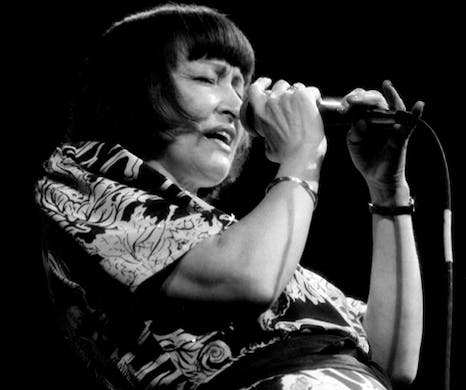The Royal Bopsters Stand Nearly Alone in Carrying On a Curiously Neglected Jazz Tradition
Lambert, Hendricks, and Ross were inarguably the major vocal group in the history of jazz, but perhaps they were too successful: Their music was so overwhelmingly beloved in the jazz world that virtually no one has even attempted to pick up their mantle.

The Royal Bopsters
‘Party of Four’ (Motema)
The Royal Bopsters, who just appeared at Birdlandand who have a pandemic-era release, “Party of Four” (Motema Records), offer a possible clue regarding a major conundrum specific to the world of jazz: Why is it that two or more jazz singers never seem to get together?
This is a problem unique to jazz, seeing as other kinds of music, like pop and country, are practically dominated by ensembles of singers. In jazz, usually the singer has to be the bandleader too, and there’s almost never more than one.
This belies the huge tradition of vocal ensembles in this music, going back nearly a century to such impeccable sibling acts as The Boswell Sisters and The Mills Brothers. The jazz vocal group reached its pinnacle with the trio of Dave Lambert, Jon Hendricks, and Annie Ross, who recorded and toured as a regular unit between 1957 and 1962.
Lambert, Hendricks, and Ross were inarguably the major vocal group in the history of jazz, but perhaps they were too successful: Their music was so overwhelmingly beloved in the jazz world that virtually no one has even attempted to pick up their mantle. There’s the Manhattan Transfer, now celebrating their 50th anniversary, and the formidable New York Voices, but that’s practically it as far as long-running ensembles go. Other groups (Plant, Montgomery, and Stritch, Rare Silk, Full Swing) lasted only for brief intervals.
While the Transfer and the Voices have always had their own groovy thing going, the Bopsters, celebrating their 10th anniversary, have a mandate directly inherited from LHR. That is: to take classic jazz performances, mostly instrumental, and rearrange them for a vocal quartet, often adding new lyrics in the process. LHR did this most famously with works from the bandbooks of Count Basie and Horace Silver, and the Bopsters have delightedly picked up where they left off.
The Bopsters work in the medium that Hendricks described as “vocalese,” by which he meant adding words to an instrumental improvisation. A typical Bopsters number might be described as an interpretation of an interpretation — for instance, “How I Love You (Let Me Count the Reasons)” is based on a solo by Dexter Gordon from 1970 on “For Sentimental Reasons.” The new words are written and sung by the Bopsters’ soloist, Dylan Pramuk and the specific melody is by Gordon, but the overall groove, the original point of departure, was established by the King Cole Trio in 1946.
That’s a relatively straightforward construct for the Bopsters, who take the concept of the contrafact — for our purposes, a piece of music based on another, existing piece of music — to a brilliant extreme. The new album, “Party of Four,” opens with two works inspired by Chet Baker, “But Not For Me” and “On a Misty Night.” The legendary trumpeter-vocalist famously recorded his definitive take on the Gershwin standard in 1954, but the Bopsters’s Pete McGuiness based his chart on a 1979 scat vocal by Baker. The new version pivots around a stunning vocal and original additional lyrics by Holli Ross, the Bopsters’s original alto voice, who died of cancer two years ago.
The group’s first album, “The Royal Bopsters Project,” which is about to be reissued by Motema in an expanded edition, featured what were among the final recorded performances by five of the founding fathers and mothers of this music, Bob Dorough, Jon Hendricks, Sheila Jordan, Mark Murphy, and Annie Ross. Although Dorough was fortunately able to contribute a track to the second album before his death in 2018, Ms. Jordan is the last one standing.
Both on the new album and at Birdland, she joined the group for “Lucky to be Me”; even pushing 94, her voice has a palpable sweetness and the quartet sounds perfect behind her.
“On a Misty Night” (on “Party of Four”) is richly complex and nuanced. Composer-pianist Tadd Dameron first recorded this classic jazz ballad — with John Coltrane, no less — in 1956. Chet Baker laid down his own interpretation in 1963, and the British singer Georgie Fame used Baker’s track as the basis for a vocal version on his 2000 album “Poet in New York.” Mr. Pramuk’s arrangement, which features soprano Amy London, draws on all of these predecessors. Not only that, it includes a spot for a bass solo by guest star Christian McBride, and, somewhere along the way, incorporates a full chorus, also with new lyrics, of “The Gypsy,” a 1945 British pop song.
All this is canon fodder for jazz nerds like myself, but the group has lovely harmonies, both sweet and savory, and swings beyond the call of duty, which is all that audiences need to know, even the hepsters who congregate at Birdland.
There’s so much going on in “Misty Night” that I can’t help thinking of the Old Testament prophet Ezekial, who, as described in a classic spiritual, gazed up at the sky and saw a Holy Vision of wheels turning inside of other wheels. There are comparable wheels within wheels here, way up in the air.

